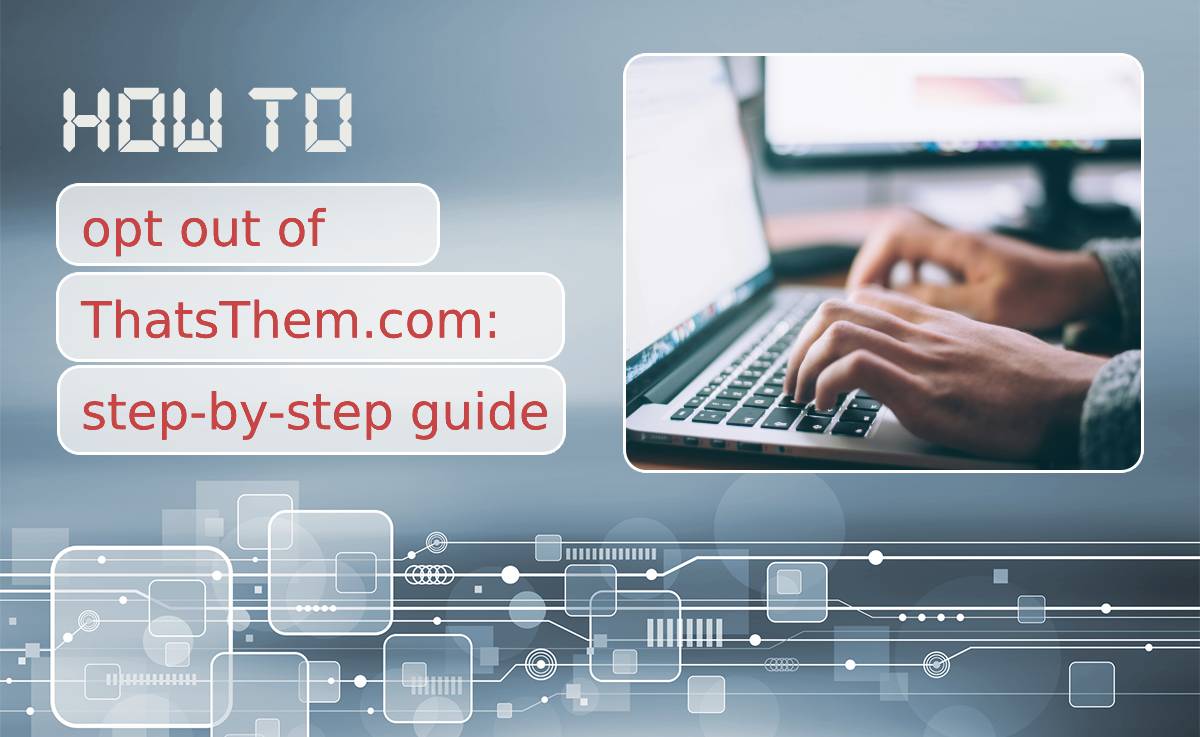In an age where personal information is more accessible than ever, the question of privacy looms large. Imagine discovering that your name, address, and even phone number are just a few clicks away for anyone with an internet connection. That’s the reality many individuals face when it comes to sites like ThatsThem.com, which aggregates public records and personal data. While this can be beneficial for certain uses, it’s easy to see how such transparency can feel intrusive and unsettling.
If you’ve found yourself wanting to reclaim your digital footprint and take control of your personal information, you’re not alone. Fortunately, opting out of ThatsThem.com isn’t as daunting as it may seem. In this step-by-step guide, we will walk you through the process—empowering you to safeguard your privacy with confidence. Whether you’re motivated by concerns over identity theft or simply wish to keep a lower profile online, our comprehensive instructions will help you navigate this essential task with ease. Let’s dive in and reclaim your right to privacy!
Table of Contents
What is ThatsThem.com?
ThatsThem.com is an online people search platform that aggregates information from various public records, social media profiles, and other data sources. This comprehensive database allows users to find details about individuals, such as contact information, addresses, and even background history. While the site can be a valuable tool for reconnecting with old friends or conducting research, it can also raise privacy concerns as personal data is made accessible to anyone with an internet connection.
One notable feature of ThatsThem.com is its capability to compile vast amounts of information in a user-friendly format. However, this ease of access means that your private details might be just a few clicks away for strangers. This duality highlights the importance of understanding your digital footprint and taking proactive steps to manage your online presence. By learning how to opt out of ThatsThem.com effectively, you take control over what personal information is shared and who has access to it, empowering you to safeguard your privacy in an increasingly interconnected world.

Step 1: Locate Your Information on the Site
Navigating a site like ThatsThem.com can feel overwhelming, especially when you’re aiming to take control of your personal information. The first step is not just about finding your data—it’s about understanding the layout and offerings of the platform. Begin by utilizing the search bar at the top of the homepage, entering your name or other identifying details. Pay close attention to any filter options; these tools can help narrow down results that might seem vast at first glance.
After executing the search, take a moment to examine each listing carefully. That’s where you’ll discover nuances in how your information is displayed—ranging from addresses to phone numbers and social media links. If multiple profiles appear, don’t be disheartened. Each entry may reflect different public records or data aggregators pulling from various sources. By recognizing that this information isn’t confined to a single account or context, you gain insight into how pervasive online identities can become—a critical realization as you embark on your journey to opt-out effectively.
Step 2: Prepare Required Personal Information
Before diving into the opt-out process on ThatsThem.com, it’s crucial to gather all necessary personal information. This preparation can streamline your experience and enhance your chances of succumbing less to frustration. Required details typically include your full name, current address, and pertinent contact information such as a phone number or email address. Additionally, any previous addresses you’ve lived at may also be necessary, as they could aid in accurately identifying your records.
Understanding the importance of precise data entry is vital—small discrepancies in names or addresses can lead to complications during the removal process. To make this task easier, consider compiling all relevant documentation that validates your identity—such as utility bills or government-issued ID—that clearly displays your name and address history. By ensuring accuracy and completeness from the outset, you pave a smoother path towards reclaiming control over your online privacy while effectively minimizing any unforeseen setbacks along the way.

Step 3: Fill Out the Opt-Out Form
Filling out the opt-out form on ThatsThem.com is a crucial step in reclaiming your online privacy. While the process might seem straightforward, it’s essential to approach it with careful attention to detail. Start by gathering any necessary information outlined on the site, including your name, address, and other identifiers that may help pinpoint your data accurately. Remember that accuracy is key; even a minor mistake could delay your request or lead to confusion regarding which records belong to you.
Once you have all required information on hand, navigate to the specified section of their website where the opt-out form resides. As you fill out each field, take a moment to consider what each element of this process means for your digital footprint. The more precise and comprehensive your input, the better chance you have of ensuring complete removal from their database. After submitting the form, keep an eye out for confirmation emails or notifications—these will provide reassurance and keep you informed about how long it typically takes for changes to reflect in their system. By making this effort today, you’re taking powerful steps towards safeguarding your personal information for tomorrow.
Step 4: Submit Your Request for Removal
Once you’ve gathered all the necessary information and confirmed your identity, you’re ready to submit your request for removal from ThatsThem.com. This step is crucial because it’s where you take tangible action toward reclaiming your privacy. Navigate to their removal page, where you’ll find an intuitive form designed for this purpose. Fill it out meticulously – any discrepancies could delay your request or lead to rejection.
After submitting, patience becomes your ally. It may take several days for them to process your request, so keep an eye on your email for confirmations or further instructions. During this period, consider documenting the request’s details—dates and any correspondence—for future reference should you need to follow up. Remember, persistence can pay off; if you notice lingering entries despite following all steps, don’t hesitate to reach out directly with a polite inquiry. You’re not just removing yourself from a website; you’re taking a stand in the ongoing battle for digital privacy that affects us all.

Step 5: Verify Your Email Confirmation
After submitting your opt-out request to ThatsThem.com, the next crucial step is to verify your email confirmation. This may seem like a minor formality, but it serves as a vital safeguard in ensuring that only you can control the visibility of your personal information. When you check your inbox and click on that confirmation link, you’re not just ticking off a box; you’re asserting ownership and taking charge of your online privacy.
While it might be easy to brush off this step or accidentally overlook it amongst the barrage of emails we receive daily, doing so could leave your data vulnerable and accessible. Consider creating a dedicated folder for important confirmations and notices—this way, you can easily track such essential messages without getting lost in digital clutter. Moreover, if you don’t see the email within a few minutes, don’t hesitate to check your spam or junk folders; sometimes these critical communications end up there due to aggressive filtering systems.
Finally, ensure that any links you click are safe before proceeding. Phishing attempts often masquerade as legitimate emails from services like ThatsThem.com. Double-check the sender’s details and examine URLs closely to help protect yourself further as you navigate through verifying your information options. Remember that every proactive measure you take strengthens your overall security posture against identity theft or unwanted exposure online.
Conclusion: Maintaining Your Online Privacy
In the digital age, maintaining your online privacy is not just a personal choice but a critical defense against the pervasive nature of data collection. As we navigate various platforms, it’s essential to recognize that our information often becomes fodder for commercial use, sometimes landing in databases like ThatsThem.com. By taking proactive steps to opt out and regularly review your online presence, you empower yourself to regain control over who sees your information and how it can be used.
But opting out is only the beginning; establishing robust habits can further shield you from unwanted scrutiny. For instance, consider using privacy-focused tools such as VPNs or encrypted messaging apps that enhance your online security while minimizing exposure to data miners. Additionally, staying informed about emerging privacy laws—like GDPR or CCPA—can help you make strategic decisions about what information to share and when. Ultimately, cultivating an awareness of digital footprints empowers you not only to protect yourself but also fosters a broader societal shift toward respecting individual privacy rights in an increasingly interconnected world.




